What is the Road?
The road is a paved way or a route or a thoroughfare which drives you to reach your destination through vehicles. Roads are classified based on different criteria, each among them is further classified into different types of roads. In this post, I give a brief description of each and every type and terms which you frequently listen when someone talks about roads. Roads are primarily classified as follows:
Different types of Roads:
Out of above, Road classification based on speed and accessibility and based on materials used is the most important.
Based on Speed and accessibility:
Freeways:
Freeways are also called as access-controlled highways.
Freeways are wide roads designed for fast-moving vehicles to travel long distances with higher speeds. These are generally designed in four lanes, two lanes in each direction. Traffic movement on freeways is continuous and unhindered because there are no railway or road intersections and no signals.
As mentioned above, access is controlled everywhere in this type of roads the driver never comes in contact with the opposing flow of traffic. To separate traffic from other roads Freeways are accessed only through ramps. Bridges or underpasses are constructed to create a passage for roads which cross freeways.
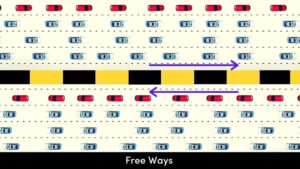
You can see from the above image that there is no obstruction and free flow of traffic in each direction.
Parking and Walking are strictly prohibited on freeways and they don’t have footpaths on either side of roads.
The minimum speed limit and maximum speed limit varies from the country by country and it ranges between 45mph to 75mph.
Expressways:
Expressways are one of the superior types of access-controlled roadways where the entry and exit of the expressway are fully controlled by ramps.
As the name itself “express” echoing that these are meant for a free flow of very speed traffic. Expressways are designed to travel quickly with great comfort and safety by avoiding sharp curves, busy traffic intersections, railway junctions.
Vehicles with high acceleration are only permitted in expressways. Heavy load vehicles, cargo vehicles, pedestrians are not allowed.
Parking, loading and unloading are strictly prohibited on Expressways.

You can see clearly the access is controlled by the left side ramp to join with the expressway.
Highways:
Highways connect villages to cities or cities to cities or state to state or the roads connect the state capital to the national capital are called highways. Highways are the roads run through the length and breadth of the country. They are generally laid in two lanes. Highways are further classified into National Highways, State Highways, Urban Highways and Rural Highways. We will discuss these types in location and function category.

Arterials:
Arterials are the roads laid inside the city or town for the movement high volume of traffic. An arterial road joins the central business point to the outside residential areas. Arterials provide access to the highways.
Pedestrians are allowed to cross the roads only at intersections or at designated pedestrian crossings. The flow of traffic is controlled by a signalling system at intersections.
Parking is not allowed on arterial roads.
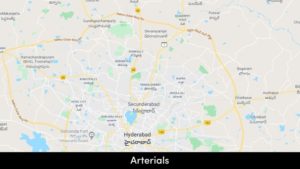
In the above image, white lanes and yellow lanes denote arterials.
Local Streets:
Local streets don’t carry a large volume of traffic like arterials. The speed limit is restricted to 30km/hr in a local street. Local streets allow you to properties around it. In simple the road which you to take to reach the nearest vegetable market is the local street.

Pedestrians can cross the road at any point in local streets. Unrestricted parking, loading and unloading of vehicles are allowed in local streets. They usually don’t have any divider with boulders but divided with 1m dotted white lines or straight white line.
Collector Roads:
Collector roads collect and deliver the traffic to and from local streets and arterials. The speed limit usually ranges between 35-55km/hr.
Pedestrians are allowed to cross only at intersections. Parking can be allowed except at peak times.

The below graph represents the speed and accessibility for different types of roads
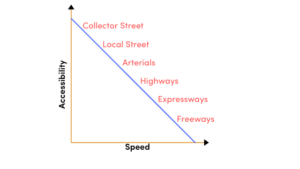
Based on Materials used:
In this category, I’m going to explain different types of roads based on the materials used in the construction of the road.
Earthen Roads:
The roads which are laid with the available soil at the site are called Earthen Roads. These are the cheapest roads among all the roads. Earthen roads are designed for very low volume traffic.
Available soil is laid in two-three layers and surface of the road is compacted with the rammer to expel the excess voids present in the soil.

These roads are also called as temporary roads usually laid for moving constructing vehicles while building a structure or for moving army vehicles during war times.
it is not recommended to go with Earthen roads in monsoon as the soil may runoff during rain.
Gravel roads:
Gravel roads are the second cheapest among all the types of roads and they are also better than Earthen roads.

In this type of roads, the mixture of gravel and earth (available soil at the site) is paved on the surface and compacted. Gravel roads are also called as metal roads. These types of roads are easily built and generally laid in villages.
Murram Roads:
Murram is a gravelly lateritic material which is occurred during the disintegration of igneous rocks by weathering agencies. The roads which are laid using Murram as primary material is called as a Murram road. The density of murram is higher than the gravel which also provides good surface finish and compaction than above two types of roads.

Kankar Roads:
The word Kankar is derived from India which means an Impure form of Limestone. This type of roads usually recommended at places having a good quantity of lime. Kankar road is one of the low-quality roads but better than Earthen roads and gravel roads.
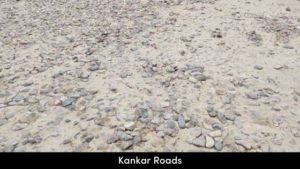
Water bound Macadam Roads [WBM]:
This type of road is also called as WBM road. The crushed stone (aggregate) is used as a base course. WBM roads are laid as layers. Aggregates are spread on the surface as a layer having 10cm thickness, water is sprinkled on each layer and then rolled for a better finish.
These roads are better than the Murram, Earth and Kankar roads.
In cities WBM is usually laid in pit holes.

Bituminous roads:
The bituminous is a black viscous and adhesive material occurred during the distillation of petrol. Bituminous roads are primarily used all over the world which is very easy to lay and provides smooth and good surface finish. The thickness of bitumen road depends upon the subgrade soil at the site. It is always recommended to lay the bitumen roads in two layers.

Concrete roads:
The roads which are laid using the cement concrete material is called concrete roads. These are the costlier roads among all type of roads. This type of roads are recommended at the places of the high volume of traffic and it takes more time to construct the concrete roads as the concrete requires proper curing. The average life of a concrete road is 40 years whereas bituminous road has an average life of 3 years.
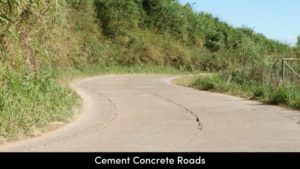
Based on Nagpur classification:
Nagpur is a city named in India. Nagpur classification is followed in major parts of the world. Let’s discuss the different types of roads based on Nagpur classification
National highways:
National highways run throughout the length and breadth of the country. These roads connect state capital cities to the national capital city. A minimum of two lanes, one for each direction is provided for National highways and these two lanes are divided by a strip of boulders.
The minimum speed of 80Kmph should be maintained on National highways. They are usually labelled with numbers NH1, NH70

State highways:
State Highways connects the important cities of the state to the state capital city. State highways give access to connect National highways. They are also connected to the state highways of the neighbouring states.
A minimum of two lanes are provided but they may or may not divided with a strip of boulders.

District roads:
District roads give access to connect to the State highways. District roads connect the important towns of the district and they are also connected with the neighbouring district roads.
There are two different types of district roads
Major District roads: These roads connect to the neighbouring district headquarters
Minor District roads: These roads connect the important towns within the district to the district headquarters.
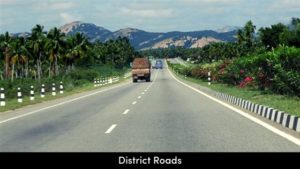
Village roads or Rural roads:
Village roads are the roads in villages. These roads lead to the nearest town and also connects to the important areas of the villages like temples, churches etc. Village roads are also connected to the neighbouring villages.
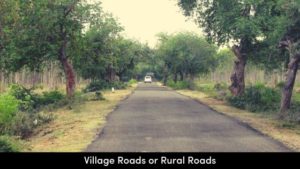
Based on usage:
All-Weather roads:
These are the roads which can be accessed throughout the year is called All-weather roads.
Fair-weather roads:
The roads which are accessed only during the fair atmospheric conditions are called Fairweather roads. Some roads are opened only during summers and rest all seasons the roads remained closed due to snow on road. These roads are not accessible during heavy rains, cyclones or at the time of floods.

You can see the above road is allowed to permit vehicles only during summer.
Based on Carriageway
Paved Roads :
The roads which are designed with a hard pavement course such as Cement concrete, Bituminous and WBM are called Paved roads.

Unpaved roads:
The roads which are not designed with a hard pavement such as Kankar, Earthen or Murram are called unpaved roads.

Based on Rigidity:
Flexible Roads:
The flexible road has four layers, the outer surface layer is topped with bituminous material which is called as wearing course and an underlying sub-base, base and subgrade course. All these layers make the road flexible. Periodic maintenance is required for flexible roads otherwise it can disintegrate easily with heavy traffic.
All roads except cement concrete roads are flexible roads.
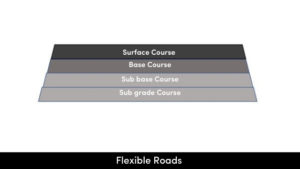
Rigid roads:
These are the roads with only three layers (Surface course, Base and Subgrade course) makes road non-flexible. Cement concrete road falls under this category.
Flexible roads consist of a flexible layer as a pavement surface, which requires proper maintenance; otherwise, it can be disintegrated easily with heavy traffic. All types of roads except concrete roads fall under this category.

Based on topography:
Roads are classified into two types considering topography they are Hilly roads and Plain roads.
Hilly roads:
The roads which are constructed on hilly areas where one can see frequent steep bends, ups and downs. The capital required is more and it takes more time when compared with the plain roads.

Plain area roads:
The roads which are constructed on the plain area where there are very few bends, ups and downs are plain area roads. Planning and execution time is less when compared with the plain area roads.

Based on the economy:
Low-cost roads:
The roads which require less capital and can be constructed with the available local soil or locally available materials are called low-cost roads. These roads are preferred where there is very low and pedestrian traffic.
Medium cost roads:
The funds required for constructing medium-cost roads are higher than the low-cost roads. Road to travel from village to nearest town is one of the examples of medium-cost roads. These roads are considered when there is occasional high traffic. These roads are generally built using bitumen.
High-cost roads:
These roads require huge capital to construct. State Highways and National highways are the best examples of the high-cost roads. Bitumen or Cement concrete is used in High-cost roads.
Based on the Volume of traffic:
This classification based on the number of vehicles passing through a specific route.
Low traffic roads:
The roads which are carrying less than 400 vehicles on an average per day is called low traffic roads. Village roads or rural roads are the best examples of this type of roads.
Medium traffic roads:
The roads which are carrying on an average of 400 to 1000 vehicles per day are called Medium traffic roads. District roads are one of them
High traffic roads:
The roads which are carrying more than 1000 vehicles per day is called High traffic roads. National and State highways fall under this category.
Based on traffic type:
Cycle tracks:
The tracks which are built especially for cycles or bicycles are called Cycle tracks. These tracks are provided on both sides of the pavement.
Pedestrian ways:
The way or a route built specifically for the pedestrians where any vehicles are strictly restricted are called pedestrian ways.
Motorways:
Motorways are expressways which are built for a free flow of very speed traffic. Expressways are designed to travel quickly with great comfort and safety by avoiding sharp curves, busy traffic intersections, railway junctions. Heavy load vehicles are strictly restricted on expressways.
FAQs on Types of Roads:
Also Read:
Highway Alignment and Factors controlling highway alignment
Superelevation and its significance in road design


Your posts are so amazing and informative. Plzz keep it up and brings more informative knowledge on your post, so that everyone could get it.
Thanks ☺️
Thanks for your appreciation
This is good article for civil engineers
Thank you so much.
Glad that you liked it share with your friends
Amazing knowledge share about road,which is help all civil engineer work in the field side.
Thanks for your sharing knowledge.
thanks for your gratitude
Thanks for posting this. It’s quite educating
This is one of the best blogs for civil engineering students to brush up their subject knowledge and learn new things.
Thanks